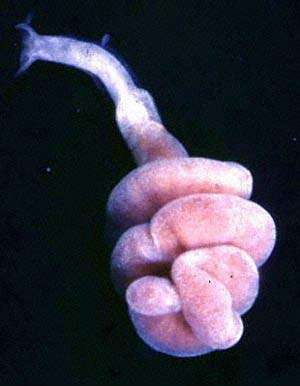
Microhedyle sp.
Order: ACOCHLIDEA
Suborder: MICROHEDYLOIDEA
Family: Microhedylidae
DISTRIBUTION
Species of Microhedyle are reported from the Atlantic coast of Europe, the Mediterranean, and the Solomon Islands and the Great Barrier Reef in the Western Pacific. A species is also reported here from Guam.
PHOTO
The specimen shown is 5.5mm in length and came from the reef flat at Anae Island [SW Guam], April 1972. PHOTO: Clay Carlson.
These are minute animals which are found living in the spaces (interstices) between sand grains and thus form part of the "interstitial fauna". The phylogenetic relationships between the various interstitial opisthobranchs is still unclear because many are very reduced in size and possibly similarities in anatomy and life history may reflect adaptations to their size and habitat rather than a close evolutionary history. At present we can't be sure of the distribution of most species because they have only been looked for by a small number of dedicated workers willing to sort through vast quantities of sand.
Authorship detailsRudman, W.B., 1998 (October 8) Microhedyle sp. [In] Sea Slug Forum. Australian Museum, Sydney. Available from http://www.seaslugforum.net/find/micrhedy
Related messages
Microhedyle from Guam
October 8, 1998
From: Clay Carlson

Bill,
Glad to hear that you are recovering well from the dissection. I've attached an animal that most people don't run into to add interest to your stay at home. So far we have had no volunteers as far as a name
goes (except for the major group which we knew anyway). We have three records of this species --all from Guam. The specimen shown is 5.5mm in length and came from the reef flat at Anae Island [SW Guam], April 1972.
Clay
Clay Carlson
Merizo, Guam
P.O. Box 8019
Merizo, GUAM
96916
clay.carlson@kuentos.guam.net
Carlson, C. & Hoff, P.J., 1998 (Oct 8) Microhedyle from Guam. [Message in] Sea Slug Forum. Australian Museum, Sydney. Available from http://www.seaslugforum.net/find/251Dear Clay,
Thanks for the occupational therapy. It certainly looks like a species of Microhedyle and it could be Microhedyle cornuta which was described from the Solomon Islands. However I would think its anatomy would need to be looked at before that could be confirmed. As shown here the body organs are contained in an elongate sac which coils when the animal is removed from its sandy home. Microhedylids are an interesting group of opisthobranchs as they are one of a very few sea slugs which have separate sexes. .. Bill Rudman.
